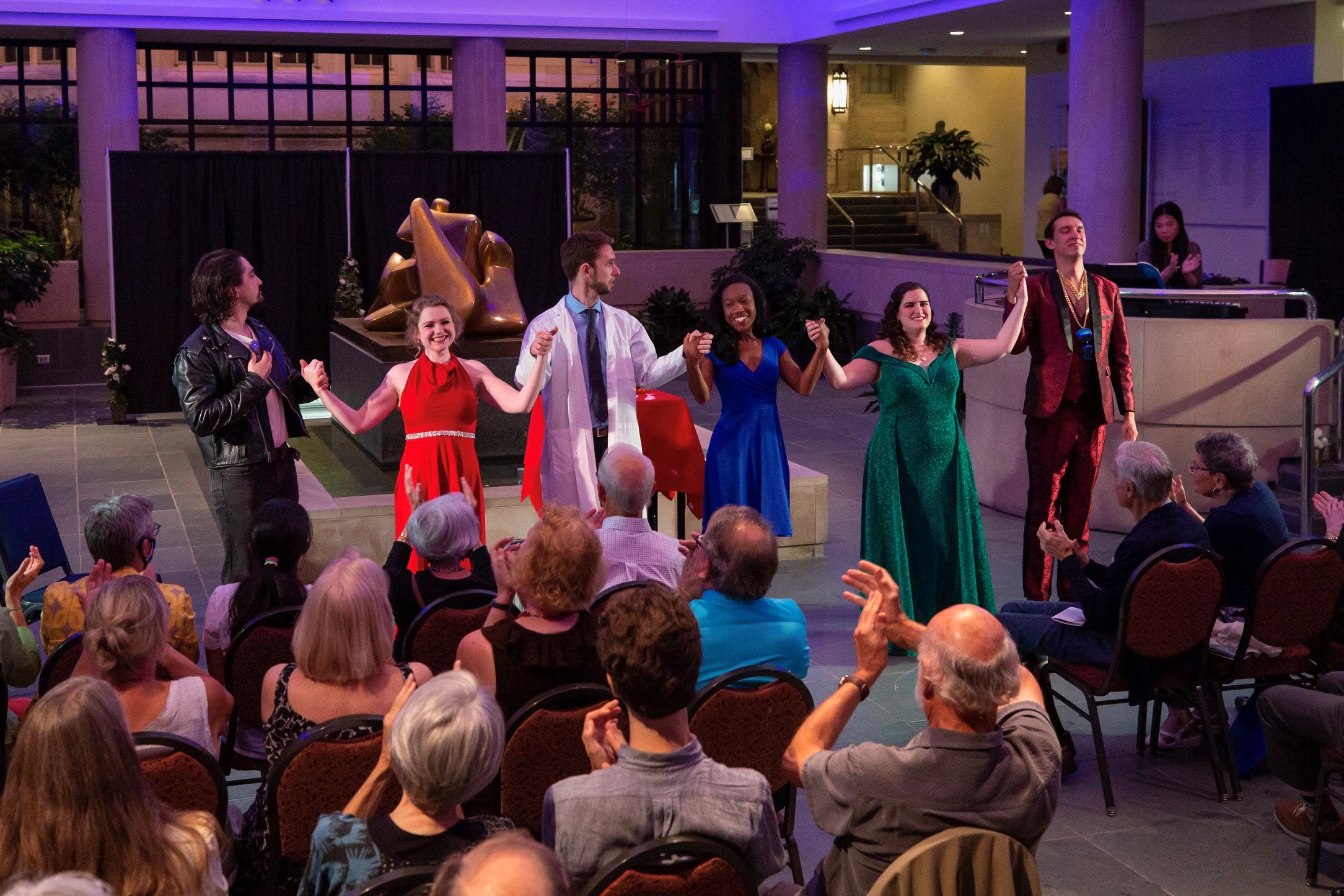Their First Time
Many opera companies' subscriptions and ticket sales have not bounced back to pre-pandemic rates, but the number of attendees brand new to the art form has jumped significantly.
The Miraculous Journey of Edward Tulane details the story of a self-obsessed porcelain rabbit learning to love someone besides himself. The children’s book won Minnesota author Kate DiCamillo several awards and has remained a heartwarming staple nationwide since its publication. In October, Minnesota Opera premiered an adaptation of Edward’s grand adventures with music by Paola Prestini and a libretto by Mark Campbell. “We had girl scouts from all the way out in California come to Minnesota because Edward Tulane was their favorite book,” says Ryan Taylor, the company’s president and general director. In fact, around 10% of the crowd, which ranged in age from young children to grandparents, were brand new to the company, drawn in by the popularity of the book.
Opera companies are struggling with diminished subscriptions and attendance in the wake of the pandemic. However, there is some good news: Record numbers of “new-to-file” patrons, or attendees completely new to the companies, are purchasing tickets. Finger Lakes Opera, a small summer festival company, notes that about a third of attendees were new faces at a performance of Mozart’s Così fan tutte at Rochester’s Memorial Art Gallery. About a quarter of attendees at Portland Opera’s November 2022 production of Carmen were new to file as well. The same was true at North Carolina Opera’s March 2022 premiere of Sanctuary Road (Paul Moravec, music; Mark Campbell, libretto). The list continues.
There are several driving causes here. First, the pandemic caused significant migration throughout the country, including among operagoers who may have found themselves attending familiar operas in unfamiliar cities. Second, companies are striking chords with new communities through stories that are well-known in other media or have more contemporary appeal, like at Minnesota Opera. Companies also formed new strategic relationships with community partners to get the word out to potential attendees who hadn’t yet been reached. And finally, it’s possible that companies’ digital efforts during the pandemic may have helped whet the curiosity of potential attendees.
Companies are keeping perspective — the number of new attendees isn’t high enough to replace the number of regular subscribers lost during COVID. However, if opera companies can continue to draw increasing numbers of new attendees, it’s certainly a step toward gaining back lost revenue. The question that has company leaders on the edge of their seats is whether they’ll be able to regularly entice these new attendees back into the theater or if the field will continue to experience this higher show-to-show turnover.

Novel Relationships
Finger Lakes Opera, which doesn’t have a dedicated home hall, celebrated its 10th anniversary season in July with performances at six different locations, including the Memorial Art Gallery. “We actually sold out the art museum,” says Elizabeth Long, the opera’s executive director. Long herself reached out to different venues to inquire about renting space and collaborating. At the gallery, about a third of that audience — around 70 people — took advantage of a discount code for museum members, suggesting some cross-pollination. Long says the gallery was pleased with the partnership and that the company will continue to work with the museum next summer.
In Nebraska, Opera Omaha shares its performing space with a Broadway-presenting organization. The opera company produces three operas a year, and during the previous season sandwiched performances of Sweeney Todd in March 2022 between Tchaikovsky’s Eugene Onegin and Bellini’s The Capulets and the Montagues. More than half of all Sweeney attendees were brand new to Opera Omaha, with many of the new attendees crossing over from the Broadway presenter. “This was right after Sondheim had passed away,” says Audience Development Manager Howard Coffin, noting that that coincidence may have increased sales. Opera Omaha, like most companies, offers attendees discounts to return for additional productions and tracks how many attendees continue to engage with the company. Only about 1.5% of the new attendees from Sweeney Todd subscribed to the 2022–2023 season. That figure varies by company.
In addition to partnering with venues, some companies turned to third parties to get the word out about performances. reached out to the news and entertainment site Converge Media, a publication that reports on and for Seattle’s Black community, to place advertisements and request coverage for the opera’s February 2022 production of Blue (Jeanine Tesori, music; Tazewell Thompson, libretto). Blue, which premiered in 2019 at the Glimmerglass Festival, centers on a Black police officer and the tensions between his job and his family and community. Over the course of its seven performances in Seattle, Blue pulled in more than 1,500 new ticket buyers, about a sixth of the production’s overall attendees. About half of those newcomers identified as Black, Indigenous, or people of color. “We’re still trying to figure out what our audience five years from now is going to look like,” says Kristina Murti, Seattle’s director of marketing and communications. “Bringing new people into the fold was always important to us, but as we recover from the pandemic, it’s more important than ever.”
While the company’s relationship with Converge Media began due to Blue’s specific narrative, it has evolved into an ongoing partnership. Converge has continued to send a correspondent, TraeAnna Holiday, to cover the opera’s productions of other works from the inherited repertoire. Holiday has attended productions ranging from Mozart’s The Marriage of Figaro to Wagner’s Tristan and Isolde. “I didn’t feel like [opera] was a space for me. ... That’s changed for me since I started going to the opera,” she said while being interviewed for a November Seattle Opera blog post. “I mean, when a character feels something, those emotions come across so strongly, right?” she said. “I didn’t know that that was something opera could do.” Seattle Opera now places paid advertisements with Converge, as well.

North Carolina Opera (NCO) in Raleigh also made overtures specifically to the Black community for its March 2022 premiere of Sanctuary Road, an opera based on The Underground Railroad Records, an 1872 book by abolitionist leader William Still. “We partnered with a couple of HBCUs in the area, primarily Shaw University,” explains Angela Grant, the company’s director of marketing. The opera company presented Sanctuary Road as an educational opportunity, with discounts for college students and talkbacks with attendees after performances. The opera sold out and drew around 700 new attendees, about 35% of the 2,000 total attendees. Shaw also hosted a post-performance reception for students and artists alike.
Like Seattle Opera, NCO is maintaining this relationship. The company has continued working with Shaw and in the fall performed a free concert on campus as part of Shaw’s Founders’ Week. Leadership at Shaw University — who took great interest in Sanctuary Road and helped promote the opera on a volunteer basis — has also joined NCO’s advisory committee, which weighs in on the company’s repertoire selection and community engagement plans.
Reprises
Most every opera company created some sort of digital content during the pandemic to keep in touch with patrons and maintain engagement. These efforts were fruitful — at many companies, even though revenue evaporated, donations increased significantly. Plus, these digital offerings actually caught the attention of significant swaths of people who hadn’t engaged with opera companies before. According to Jen Benoit-Bryan, president at Slover Linett Audience Research, opera companies saw more engagement from people who hadn’t been through their doors in recent years than did any other art form. “About 57% of people who hadn’t previously engaged with opera companies did so through digital channels during the pandemic,” she says.
This doesn’t necessarily prove that digital offerings brought in more new attendees when companies got back on stage, but it’s possible that they helped. Take Boston Baroque, a period instrument organization that puts on just one opera a season as well as other concerts. During the pandemic, the company partnered with GBH TV and the classical music streaming service IDAGIO to present concerts and operas for a live and virtual audience. In-person tickets to the company’s April 2022 production of Handel’s Amadigi di Gaula sold out completely. Streaming numbers were similarly strong, and the company estimates about 500 of the 1,400 total viewers were first-timers. “New people are coming, and they’re buying last minute,” says Emily Kirk Weddle, Boston Baroque’s director of marketing and digital content. “Plus, if you are in a city that doesn’t have opera, our product can fill that niche without the need to travel. It’s not location-based, it’s interest-based.” Many companies wrestled with how to monetize digital offerings, with a majority deciding to abandon such content once they began performing for in-person crowds once more. Boston Baroque’s digital sales made up fully 30% of earned revenue during the 2021–2022 season, in part thanks to digital-only subscriptions and a pay-as-you-wish ticket sales model that Weddle says proved both popular and lucrative.

Still, the question for all of these organizations remains: Did new attendees have a good enough time that they’ll want to return? At Portland Opera, Carmen brought in more than 1,500 new listeners and exceeded ticket revenue goals, which General Director Sue Dixon attributes to Carmen’s name recognition. What did the new attendees think? “Well, we’re the queen of surveys,” Dixon says. “As soon as someone walks out of the theater, we send them a link asking if they enjoyed the show and what they would change and whether the quality matched the price of admission,” she says. First-time attendee responses to Carmen were all over the map, which is typical, she adds with a chuckle. Many were thrilled with the opera — some didn’t think the experience was worth the price point. “We take the responses with a grain of salt,” Dixon adds. “The surveys give us checks and balances.”
Long before the pandemic, the most famous operas were typically the most successful at bringing new attendees out to try opera. Now, it seems that companies’ ability to emphasize how a production specifically relates to their community or taps into broader culture is also driving new people to the opera house. Even the Metropolitan Opera in December announced it would begin pivoting away from inherited repertoire in favor of more contemporary work. Beyond this, though, many new attendees are returning. After Carmen, 10% of audience members took advantage of a discount offer sent out to new attendees. These numbers aren’t enough to replace lost subscribers and ticket buyers, but it’s a start. “I don’t want to take away from this success, but I don’t want to assume it’s a trend yet — it needs to be ongoing,” Dixon says. “The true test will be our next few productions.”
This article was published in the Winter 2023 issue of Opera America Magazine.

Jeremy Reynolds
Jeremy Reynolds is the editor of Opera America Magazine and the classical music critic at the Pittsburgh Post-Gazette.









